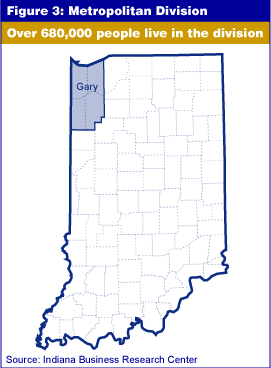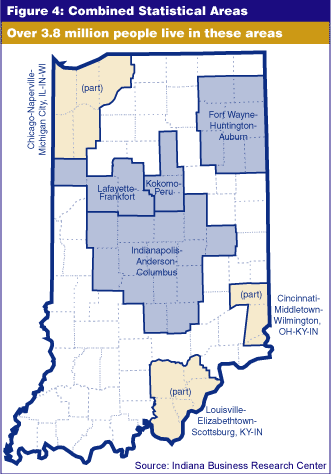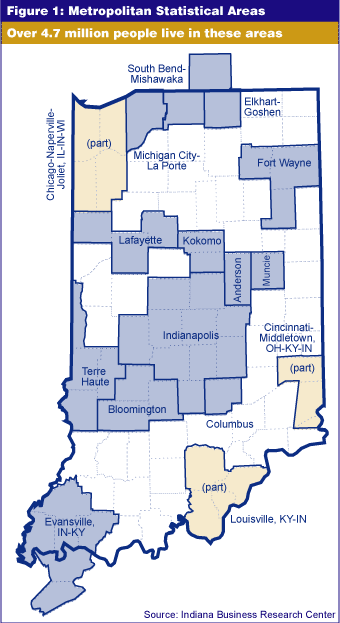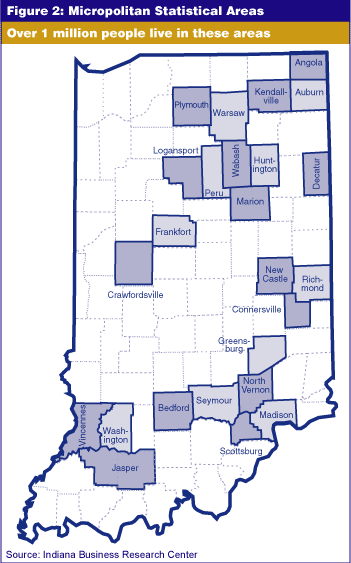A New Metro Landscape for Indiana
Indiana is sporting a new look for its metropolitan areas, as newly defined by the federal government in June 2003. What does it look like, and what does it all mean? We can answer the first with maps and descriptions, but it is too early to know what the full impact of these newly defined areas will mean for Indiana.
Statistical groupings of counties were first federally defined in the 1950s, with six Standard Metropolitan Statistical Areas (SMSA) for Indiana. Through the decades, as Indiana's population became increasingly urban, the numbers of those areas grew so that by the 1990s there were 11 metro areas.
With the latest configuration of statistical areas, the majority of Indiana counties are in either a metropolitan statistical area (metro) or a micropolitan statistical area (micro), with more than 5.7 million Hoosiers living in these areas.
Thirteen Metropolitan Statistical Areas
These include the two newly defined metropolitan statistical areas of Michigan City (La Porte County) and Columbus (Bartholomew County). The definition of a metropolitan statistical area requires an urbanized area with a population of 50,000 or more and adjacent territory with a significant degree of social and economic integration as measured by commuting. While 13 metropolitan areas have principle cities within state lines, three additional metro areas contain Indiana counties (see Figure 1). More than 4.7 million people live in Indiana’s metropolitan counties.
Twenty-Five Micropolitan Statistical Areas
These are a new set of statistical areas, defined as having at least one urban cluster with a population of at least 10,000 but less than 50,000 (see Figure 2). The urban clusters also have adjacent territory with a high degree of social and economic integration as measured by commuting. More than 1 million people in Indiana live in these micropolitan areas.
One Metropolitan Division
A metropolitan statistical area containing a single core with a population of 2.5 million or more may be subdivided to form smaller groupings of counties referred to as metropolitan divisions.
Gary is now labeled as a metropolitan division (Lake, Porter, Newton and Jasper counties) of the Chicago-Naperville-Joliet Metropolitan Statistical Area (see Figure 3). More than 680,000 people live in the Gary division of the Chicago metro area.

Four Combined Statistical Areas
If specified criteria are met, adjacent metropolitan and micropolitan statistical areas, in various combinations, may become the components of a new set of areas called combined statistical areas (CSAs). For instance, a combined statistical area may comprise two or more metropolitan statistical areas, two or more micropolitan statistical areas, or combinations of metropolitan and micropolitan statistical areas. Indiana has four such areas within its borders, and three others that include Indiana counties (see Figure 4). More than 3.8 million Hoosiers live within combined statistical areas.

What Does This Mean for Hoosiers?
Overall, Indiana has significantly increased the number of metro areas for which statistical data will be made available. This will put Indiana on a variety of lists, benefiting site locators who find these lists convenient for comparing metro areas within states, across regions and throughout the nation. According to the federal Office of Management and Budget (OMB), these areas are defined only for the collection and tabulation of statistical data by the federal government.
However, even though the OMB advises against the use of these definitions for nonstatistical (and particularly funding) purposes, many federal agencies do use these convenient groupings of counties for funding purposes—directly or indirectly. Federal agencies such as Housing and Urban Development, the Department of Agriculture and Health and Human Services have used these definitions for grant disbursement and other funding purposes. At this point, no specific information is available outlining their use of the new definitions.
Carol O. Rogers
Associate Director, Indiana Business Research Center,
Kelley School of Business, Indiana University


